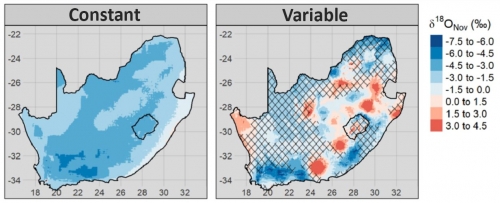Return Mail Campaign Reveals Two Tap Water Worlds Across SA


South Africa is a water-stressed country. Increasing demand for water, together with uncertain supply due to climate change and catchment degradation, makes the delivery of municipal water a challenge. It is expected that, by 2030, the demand for water will be 18%–25% greater than the sustainable supply. There is thus an urgent need to understand more about the sources of tap water, their potential variability and how or when they are recharged.
Source of Tap Water across South Africa
Research by MSc student Ruan de Wet, together with Associate Professor Adam West and Professor Chris Harris, set out to discover the likely source of tap water across South Africa. They used the Post Office to assist them in getting a National-level dataset of tapwater in a rapid and cost-effective manner. By running the study in different seasons, they could pick up which places had stable (groundwater) versus variable (surface water) tap water sources. Previously, the only national level groundwater map was done at great expense by directly sampling boreholes across the country over 18 months from 2006-2007. This method is a major breakthrough for sampling this precious resource at high temporral and spatial frequency
Citizen Science: Enlisting the Post Office to help with sampling
The researchers followed a citizen-science sampling approach to make the sampling cost-effective and rapid. They sent out envelopes addressed to 340 post office branch managers throughout the country at the end of the winter and summer season. In each envelope was an information pack, instructions and a request for their assistance in providing tap water along with two vials and a postage-paid return envelope to be sent back to our research lab. Within a short space of time, two-thirds of the post office branches had provided samples with their tap water. This allowed the researchers to create a cost-effective and nearly synchronous map of tap water across the whole country.
Two Tap Worlds
They then used the chemical signatures hidden in tap water (the so called “isotopic ratios” of oxygen and hydrogen) to show that there are two different “tap water worlds” - a surface world (that is linked to surface water resources like dams and reservoirs) and a underground world (that is linked to deep, possibly ancient, groundwater resources below the surface).
In doing so, this research helps to understand our dependence on surface versus deep water resources, and demonstrates a cheap and effective way to sample groundwater that should allow regular monitoring of this crucial resource into the future.

Universal kriging model predictions of , δ18O from the November 2017 category A (right) and B (left) samples. Hatching indicates areas where the model uncertainty is greater than one standard deviation of the underlying data.
To see the full paper, read here
